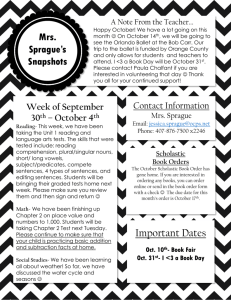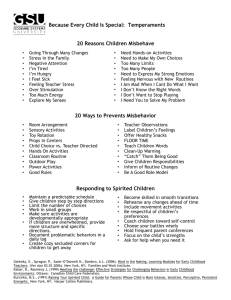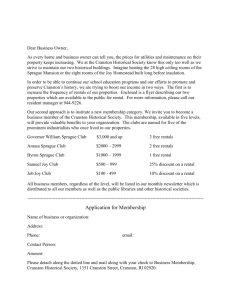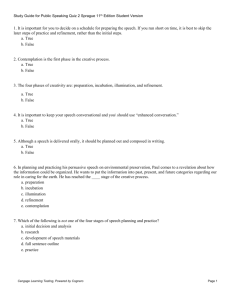Persusasive and last chapters PowerPoint
advertisement
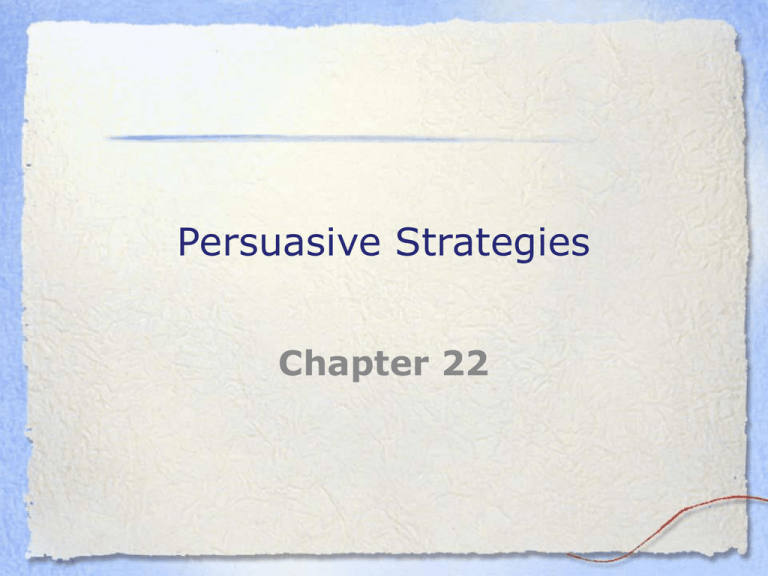
Persuasive Strategies Chapter 22 Analyze your Persuasive Goals • Identify whether you need a proposition of fact, value, or of policy (more shortly) • Use stock issues to help you analyze your topic • ** Use a specific, planned organizational pattern ** Sprague Chapter 22 2 Adjust Your Content Based on Your Audience Attitudes • Favorable audience • Neutral audience • Unfavorable audience Sprague Chapter 22 3 Favorable Audience • Use emotional appeals to intensify your listeners’ support • Seek a public commitment from listeners Sprague Chapter 22 4 Favorable Audience • Tell your audience exactly what actions they can take • Give your listeners ammunition to answer opposing points Sprague Chapter 22 5 Favorable Audience • Create an environment by letting your listeners “fill in the blanks” in your argument – Enthymeme -- an informally stated syllogism (a three-part deductive argument) with an unstated assumption that must be true... Sprague Chapter 22 6 Neutral Audience • Use plenty of attention factors • Make sure your point is clear and understandable Sprague Chapter 22 7 Neutral Audience • Present the most recent evidence and examples you can find • Send your message in multiple ways to engage the senses • Blend logic and emotional appeals Sprague Chapter 22 8 Unfavorable Audience • Be realistic about what change you ask listeners to make • Emphasize common ground • Be very thorough in your reasoning • Build your credibility by being fair and open minded Sprague Chapter 22 9 Organize Your Points for Optimal Persuasive Impact • Use Monroe’s Motivated Sequence to engage your audience 1. 2. 3. 4. 5. Sprague Attention step Need step Satisfaction step Visualization step Action step Chapter 22 10 Organize Your Points for Optimal Persuasive Impact • Compare the advantages of two proposals as a way of organizing your speech • Place Your Strongest Points First or Last • Consider Dealing with Opposing Arguments Sprague Chapter 22 11 What kind of proposition? • Proposition of fact – Draw inferences from available date – Is / is not • Proposition of value – Good or bad, right or wrong • Proposition of policy – Most common, most complex – Advocates specific course of action – Should / should not Types of claims (propositions) • When addressing whether something is true or not, or something will or won’t happen-make a claim of fact • When addressing an issue that relies on individual judgment of right or wrong for its resolution, make a claim of value. • When proposing a specific outcome or solution to an issue, make a claim of policy. • Write your specific purpose to include one Organizing Persuasive Messages • • • • • Problem-solution (p. 148) Comparative Advantages (p. 324) Refutation Pattern (p. 325) Motivated Sequence 1. Attention 2. Need 3. Satisfaction 4. Visualization 5. Action You must use one of these -- list at top of outline Example: Problem-Solution • • • • I. The Nature of the Problem II. Reasons for the Problem III. Unsatisfactory Solutions IV. Proposed Solution The Bottom Line • Read and peruse lots of sources • Use the best 10 or so sources -Retrievable reminder • Make it clear to the audience where your information comes from • Define terms, identify people • Know the topic well and speak with conviction What type evidence? • Examples, stories, testimony, facts, statistics… • Distortion -- what is truth? • Historical vs. contemporary views • Sources of your evidence • Sources of visual aids • APA style -- accurate does matter Ethics and appeals • • • • • • Teleological vs. deontological Emotional vs. rational appeals Audience sensitivity Life Cycle analysis Demographics differences Culture and subcultures Persuasive Speech final topics... ...questions Modes of Delivery Chapter 23 Use of Four Steps to Prepare an Extemporaneous Speech • Begin with a fully developed outline • Convert the full-sentence outline into a key word or key phrase outline • Word the speech • Convert your keyword outline to speaker’s notes Sprague Chapter 23 21 Remember Four Steps When Speaking Impromptu • Keep your composure • Select a theme • Select organizational framework • Whenever possible, plan your first and last sentence Sprague Chapter 23 22 Speaking from a Manuscript • When the time allotted is specific and inflexible / duplicate deliveries required • The wording is extremely critical • The style is extremely important Sprague Chapter 23 23 Prepare an Easily Readable Manuscript • Don’t write it out by hand • Use capital and lowercase letters in a standard sentence format • Print on heavy paper • Make sure letters are dark and legible Sprague Chapter 23 24 Memorize Certain Manuscript Speeches • Memorize the structure first • Read the speech aloud several times, then paragraph by paragraph Sprague Chapter 23 25 Memorize Certain Manuscript Speeches • As you practice, visualize giving the speech • Do not go into a trance when delivering the speech • If you go blank, recall the structure of the speech Sprague Chapter 23 26 Practice Sessions Chapter 24 Get Effective Feedback • Form a feedback support group • Get guidelines for feedback Sprague Chapter 24 28 Allow Time for Three Stages of Practice • Use early sessions to flesh out your outline • Use middle sessions to get feedback Sprague Chapter 24 29 Allow Time for Three Stages of Practice • Practice in front of others and ask for their feedback • Record your practice session and analyze your performance Sprague Chapter 24 30 Allow Time for Three Stages of Practice • Use final sessions for refinements • Make it as realistic as possible Sprague Chapter 24 31 Prepare Speech or Speaker’s Notes • Include key words, phrases and material that is to be cited directly • Prepare speech notes in a format that aids delivery • Preparing speech notes on note cards Sprague Chapter 24 32 Fit Your Speech into the Time Limit • If your speech is too long – Consider cutting out an entire point – Eliminate redundant evidence – Reduce narratives Sprague Chapter 24 33 Fit Your Speech into the Time Limit • If your speech is too long – Eliminate long stories – Use visuals or handouts – Speak simply – Is this too complex a topic? Sprague Chapter 24 34 Fit Your Speech into the Time Limit • If your speech is too short – Make sure all of your points are well developed – Use repetition – Is this a good enough topic? Sprague Chapter 24 35 Fit Your Speech into the Time Limit • If your speech is too short – Make sure you have proved all of your points – Do some more research – Change organizational pattern? Sprague Chapter 24 36 Avoid Common Practice Pitfalls • Doing mental rather than oral / physical practices • Avoid too many critics Sprague Chapter 24 37 Avoid Common Practice Pitfalls • Avoid over preparation • Avoid self-consciousness rather than audience consciousness Sprague Chapter 24 38 Adapting to the Speech Situation Chapter 28 Prepare & Adapt to Audience Reactions • If your audience seems bored or restless • If you are not getting the agreement from the audience you expected Sprague Chapter 28 40 Prepare & Adapt to Audience Reactions • If your audience is less informed that you expected • If your audience is more informed than you expected Sprague Chapter 28 41 Prepare & Adapt to Audience Reactions • If you audience is more heterogeneous than you expected Sprague Chapter 28 42 Take Steps to Prevent Distractions • Check for possible sources of distractions • Ignore low level distractions in your speech • Incorporate distractions into your speech Sprague Chapter 28 43 Take Steps to Prevent Distractions • Make necessary interruptions as short as possible and draw your listeners back into the speech Sprague Chapter 28 44 Responding to Hecklers • The verbal heckler – First-level tactics – Second-level tactics • The nonverbal heckler Sprague Chapter 28 45 Answering Questions Chapter 29 Answering Questions • Come prepared • Invite & answer audience questions straightforwardly Sprague Chapter 29 47 Manage SelfIndulgent Questioners • The person who wants to give a speech • The person who wants to have an extended dialogue • The person who wants to pick a fight Sprague Chapter 29 48
